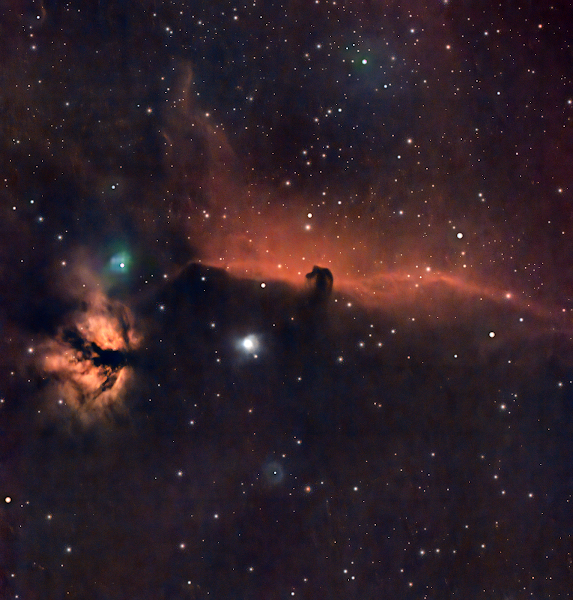The trials, tribulations and small triumphs of a Charlotte, NC astronomer imaging under Bortle 8/9 skies.
Tuesday, February 18, 2025
The Horsehead Nebula with the Dwarf 3
Here's an image of the Horsehead Nebula captured under my Bortle 8/9 skies. There's 2.38 hours of total integration time, captured in 45s/gain 60 individual exposures with DB filter. I processed the image in Siril, Topaz Denoise, and Affinity Photo.
Tuesday, February 11, 2025
The Moon--First Light with the D3
This is my first light image with the Dwarf D3. The moon was low in haze, and moved between tree branches during the imaging session. Nevertheless, the D3 captured a decent amount of detail for a 35mm imaging lens. This image is heavily cropped as the scope has a very wide field of view. The scope captures MP4 videos, and I took 1000 frames, coverted them to AVIs in PiPP, and stacked and processed 700 of them in Registax 6.
A New Toy--the Dwarf D3 telescope
Another toy arrived yesterday--the DWARFLAB D3--a tiny scope with a 35 mm 6-element apochromatic main imaging lens and small wideangle lens for Milky Way imaging (among other things). Of course, the clouds rolled in, but I was able to do some imaging, most of it through the clouds themselves. My first light object was the Moon, just to check focusing and function. I'll post that image later. The second was M42 because it is relatively bright and easy to capture. Setting up the scope in EQ mode was a simple, semi-automated process. The imaging chip in the scope, a Sony IMX678 Starvis 2 does an excellent job of capturing faint images with relatively low noise. I captured 40 minutes of M42 before heavy cloud came in, using the built-in narrowband filters in the scope. I drizzle processed the image stack in Siril as the scope significantly undersamples (making the native 4K frame 8K). I then heavily cropped the image horizontally, and the result (below) is quite pleasing. The original frame was much wider, and promises to offer great capabilites to image larger DSOs (like the Heart Nebula, for example). The scope is so small, you could almost clip it to your belt, so its a definite travel scope for me.
Saturday, February 8, 2025
A Runaway Star
A runaway star careening through space at 36 miles per second, emitting a storm of radiation that energizes the nebula it ploughs through. While this scenario sounds like science fiction, it can be found easily in the night sky in the form of the Flaming Star Nebula. IC405 is both an emission and reflection nebula in the constellation Auriga. The central star, AE Aurigae, is a runaway and probably began its journey in the area of Orion’s belt, perhaps as part of a high radial velocity binary system from which it was ejected when its companion went supernova. The nebula itself is about 9 light years across, and is a turbulent mix of gas and dust, The presence of dust in the region of the star suggests that it only recently entered the nebula and that the period of the cloud’s most extensive modification lies ahead. This image is a stak of 4.5 hours total integration, processed in Siril and Affinity.
Wednesday, February 5, 2025
Seestar S50 mosaic of M81 and M82
This is a mosaic of M81 and M82I captured last night with the S50. I set the scope in EQ mode and captured just over 5 hours of data in 20s individual integrations. I did not use the DB filter. I used the FIT format mosiac put together by the Seestar, and tweaked it in Siril and Affinity Photo. I'm very pleased with the way mosaic mode is working now. It seems to be faster and it does a better job of assembling the mosaics.
Tuesday, February 4, 2025
M42
M42 is a tempting target for a small scope. Even a few minutes of imaging will capture a surprising amount of detail. Though easy to image, the nebula is tough to process as the bright core inevitably "blows out" unless great care is taken. My aim in this image was to capture subtle details and colors in the main nebula and the attendant Running Man Nebula, while leaving the stars of the Trapezium visible in the heart of M42. This image has a total integration time of 3.3 hours. It was processed with Siril and Affinity Photo.
Subscribe to:
Comments (Atom)
Jupiter--The Wonder that is Digital Processing :)
I found an old image of Jupiter I took in 2022 on 12/25. It was captured with a QHY camera and my 5 inch MAK. The stacked image looked so un...

-
I had a couple of emails asking how to defork an ETX telescope. The ETX 90 and ETX 125 were optically superb scopes, but the mounts left a...
-
The ZEQ25 doing its stuff on a cold night--imaging the Orion Nebula with an 8 inch f/4 astrograph. Note the lovely Christmas rug :) As ...
-
One of the great things about being a part of an online community of people with similar interests is that you learn a lot from people who a...








